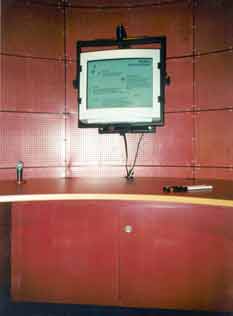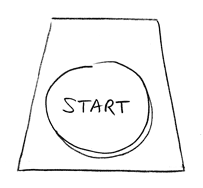| back to index | |||
H5 Simple Impression * |
|||
 The WorldBeat exhibit when not in use. |
|||
|
...you have decided to create an attractive, innovative
system - Attraction Space. Now you need to find a way to lure people into using your system, and not become
frustrated with it.
|
|||
|
* * *
|
|||
| Interactive exhibits are supposed to convey often complex
messages, and show the power and fascination of intricate new
technology. However, users of such systems are typically first-time,
and one-time users with no time to go through a long learning curve.
|
|||
| WorldBeat: Few, simple devices |
The WorldBeat includes a complex variety of innovative hard- and software, such as infrared batons, or algorithms to retrieve songs through hummed queries. Its goal is to convey how computers support new ways to interact with music, so the power of those technologies is part of its message. However, the typical user has never before encountered the system, probably never will again, and only intends to spend a few minutes with it to "see what you can do here". Therefore, the system was designed to convey a very simple, inviting system image to the user. It only offers few, non-professional input devices (neither computer keyboard nor piano keyboard), no shortcuts to circumvent the hierarchical navigational structure, and often just one choice where more would have been simple to implement. |
||
| Simple Finder |
Some operating systems offer a specific "simple mode" of operation geared towards unexperienced users. It removes access to advanced features from the user interface, simplifying the impression that the system conveys. An example is the Simple Finder option in Mac OS®. |
||
|
Therefore: Make the user interface of your interactive exhibit as simple as possible, and communicate this simplicity visually through the appearance of the system as a whole. Compromise usage efficiency, customizability, and feature-richness in favour of a system that is easy to use, no matter how advanced the underlying technology may be. |
|||
 |
|||
|
* * *
|
|||
|
To convey a simple impression, try hiding complex
hardware from view - Invisible Hardware.
To combine this initial impression with a rich set of available
features, introduce them gradually upon user
initiative - Incremental Revealing.
|
|||
This pattern is taken from the book "A Pattern Approach to Interaction Design" (PAID) by Jan Borchers (John Wiley and Sons, Chichester, UK, 2001). Copyright 2001 John Wiley and Sons. Used by permission. See http://media.informatik.rwth-aachen.de/paid.html for more information. Online version by Susan Babutzka, ETH Zurich (subabutz@student.ethz.ch). |
|||